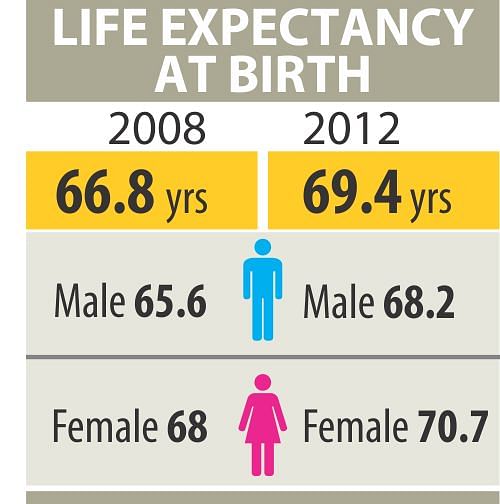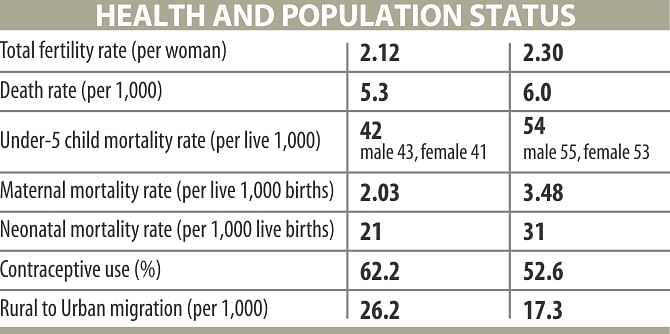People living longer
People living longer
Survey finds nearly 3 years added to life expectancy; death, birth rates drop
 The people of Bangladesh are living longer, reflecting a significant progress in the country's health and population status.
The people of Bangladesh are living longer, reflecting a significant progress in the country's health and population status.
Life expectancy rose to 69.4 years in 2012 from 66.8 years in 2008, an increase of 2.6 years in four years, according to a new survey of Bangladesh Bureau of Statistics (BBS).
Experts attribute the progress to overall economic development, expansion of health services, better access to telecommunications and a rise in literacy rate.
The BBS, in the survey, has also found declining birth and death rates.
"Reduction in child mortality has a direct link to the rise in life expectancy at birth. Bangladesh has been doing quite well in reducing child mortality. So life expectancy is up," said population expert Prof Nurun Nabi, vice chancellor of Begum Rokeya University, Rangpur.
The under-5 child mortality rate fell to 42 per 1,000 live births in 2012 from 54 per 1,000 live births in 2008, says the BBS report on Sample Vital Registration Systems (SVRS) that is yet to be released.
According to the survey, the total death rate per 1,000 people a year now stood at 5.3, down from 6.0 in 2008. The death rate is more in rural areas (5.7) than urban areas (4.6).
Also, maternal mortality rate came down to 2.03 per 1,000 live births in 2012 from 3.48 in 2008.
Total fertility rate (TFR) declined to 2.12 from 2.30, which means a woman aged between 15 and 49 now has 2.12 children.
 Experts said availability of contraceptives and increased literacy rate contributed to the reduction in TFR.
Experts said availability of contraceptives and increased literacy rate contributed to the reduction in TFR.
Nurun Nabi said despite limitations, public health services, especially in the rural areas, have expanded. Community clinics are constantly providing primary healthcare services at ward level and NGOs are playing important roles in reaching healthcare to the doorsteps of the people, he said.
Private healthcare services too have contributed to the progress in urban healthcare, Nabi added.
Many NGOs funded by the development partners provide door-to-door health services, especially on family planning and maternal-child health services.
"Most people now use mobile phone. They can call a doctor or someone who can help in an emergency," Nurun Nabi told The Daily Star.
Over 10 crore people in Bangladesh now use mobile phones.
He, however, said with the increase in life expectancy, there would be more aged people among us. In that case, old age diseases would go up.
"We must improve the medical care for old people," he said.
He also noted that neonatal mortality (death before 28 days of birth) in Bangladesh is still quite high, which is 21 per 1,000 births. Fifty percent of them die in 24 hours after birth, he said.
Neonatal care must be given special attention, he suggested.
Ubaidur Rob, country director of Population Council, an international NGO in Bangladesh, said while there is progress in population and health indicators, there are a number of challenges as well.
Unintended pregnancy is still on the rise due to short-term contraceptive use, mostly pills. This leads to abortion, Rob added.
"More permanent methods like sterilisation are to be used for birth control," he said.
Healthcare services for the urban poor are not sufficient. As more people are migrating to cities, improving urban health care is now of utmost importance, he said.
Prof Nurun Nabi suggested creating more jobs in rural areas that will check rapid rural-urban migration and keep demographic balance.